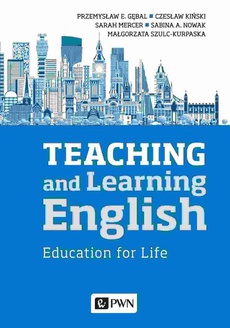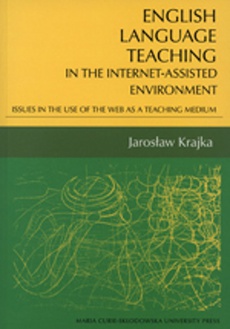POLECAMY

Teaching English to Young Learners
Wydawca:
Format:
ibuk
Podręcznik do dydaktyki nauczania języka angielskiego dzieci, napisany przez specjalistki w tej dziedzinie. Książka uwzględnia specyfikę polskiej szkoły: organizację systemu edukacji oraz standardy i minima programowe. Dzieli się na 2 części:
Część 1 – READINGS czyli właściwy podręcznik, omawia podstawy teoretyczne oraz problemy:
- nauczania dzieci w różnych grupach wiekowych (przedszkole, klasy I-III i klasy IV-VI);
- nauczania języka (słownictwo, gramatyka, wymowa);
- nauczania poszczególnych sprawności językowych (czytanie, mówienie, pisanie, słuchanie);
- metod i technik nauczania;
- planowania lekcji, oceniania, portfolio językowego.
Część 2 – TEACHING TRAINING liczy 20 sesji sprawdzających opanowanie poszczególnych działów i umiejętności wykorzystania ich w praktyce szkolnej.
| Rok wydania | 2009 |
|---|---|
| Liczba stron | 384 |
| Kategoria | Język angielski |
| Wydawca | Wydawnictwo Naukowe PWN |
| ISBN-13 | 978-83-01-15339-7 |
| Numer wydania | 1 |
| Język publikacji | angielski |
| Informacja o sprzedawcy | ePWN sp. z o.o. |
Ciekawe propozycje
Teaching and Learning English
do koszyka
TEACHING ENGLISH as a Foreign Language
do koszyka
Teaching English Through Culture
do koszyka
English language teaching In the...
do koszyka
Spis treści
| Introduction | 9 |
| 1. Early foreign language learning in Europe | 11 |
| 2. Approaches, methods and techniques | 18 |
| 2.1. Planning courses and designing syllabuses | 19 |
| Tasks | 23 |
| Further reading | 24 |
| 2.2. Integration of English and the primary curriculum | 24 |
| 2.2.1. Integration through the topic – topic-centred learning | 27 |
| 2.2.2. Integration through the method – activity-based learning | 29 |
| 2.2.3. Task-based learning | 33 |
| 2.2.4. Integration through the teacher | 35 |
| 2.2.5. Content and Language Integrated Learning (CLIL) | 35 |
| 2.3. Language development in the school | 39 |
| 2.4. Non-linguistic skills in the language classroom | 41 |
| 2.4.1. Cognitive tasks | 41 |
| 2.4.2. Creative tasks | 45 |
| 2.4.3. Bank of activities | 53 |
| Tasks | 55 |
| Further reading | 55 |
| 3. Lesson planning | 56 |
| 3.1. Lesson aims and objectives | 56 |
| 3.2. Principles of lesson planning | 58 |
| 3.3. Factors influencing what happens in the classroom | 59 |
| 3.4. Planning lessons with different age groups | 60 |
| 3.5. Bank of activities | 64 |
| Tasks | 64 |
| Further reading | 64 |
| 4. Language in the classroom | 67 |
| Tasks | 68 |
| Further reading | 73 |
| 5. Classroom management | 74 |
| 5.1. Principles of managing YL classes | 74 |
| 5.2. Discipline problems | 77 |
| 5.3. Managing different age groups | 81 |
| 5.4. Bank of activities | 85 |
| Tasks | 85 |
| Further reading | 87 |
| 6. Involving parents in the process of management | 88 |
| 6.1. The role of parents | 88 |
| 6.2. Information for parents | 90 |
| 6.3. Homework | 93 |
| 6.4. Bank of activities | 96 |
| Tasks | 97 |
| Further reading | 97 |
| 7. Teaching the language | 98 |
| 7.1. Teaching vocabulary | 98 |
| 7.1.1. Acquisition of words | 98 |
| 7.1.2. Vocabulary acquisition and child development | 99 |
| 7.1.3. Choice of words | 100 |
| 7.1.4. Word difficulty | 101 |
| 7.1.5. The role of memory in vocabulary acquisition | 102 |
| 7.1.6. Vocabulary learning strategies | 103 |
| 7.1.7. Vocabulary teaching techniques | 103 |
| 7.1.8. Procedures for introducing words to children | 106 |
| 7.1.9. Teaching vocabulary to different age groups | 107 |
| 7.1.10. Bank of activities | 108 |
| Tasks | 109 |
| Further reading | 109 |
| 7.2. Teaching grammar | 109 |
| 7.2.1. Formulaic language | 110 |
| 7.2.2. The grammar of words in context | 111 |
| 7.2.3. Playing with grammar | 112 |
| 7.2.4. Teaching structures | 113 |
| 7.2.5. Conditions for teaching grammar | 114 |
| 7.2.6. Teaching grammar to different age groups | 116 |
| 7.2.7. Bank of activities | 116 |
| Tasks | 117 |
| Further reading | 117 |
| 7.3. Teaching pronunciation | 117 |
| 7.3.1. Implicit vs explicit teaching of pronunciation | 118 |
| 7.3.2. Rhythm | 119 |
| 7.3.3. Types of pronunciation activities | 119 |
| 7.3.4. Pronunciation activities for different age groups | 122 |
| 7.3.5. Bank of activities | 123 |
| Tasks | 124 |
| Further reading | 124 |
| 11. Activities and resources | 187 |
| 11.1. Music, songs, chants and rhymes | 187 |
| 11.1.1. Music and language acquisition | 187 |
| 11.1.2. Rhythm, music and dance in education | 189 |
| 11.1.3. Using songs, chants and rhymes | 192 |
| 11.1.4. Musical and rhythmical activities for different age groups | 197 |
| 11.1.5. Bank of songs, chants and rhymes | 197 |
| Tasks | 203 |
| Further reading | 203 |
| 11.2. Play and games | 203 |
| 11.2.1. Playing and learning | 203 |
| 11.2.2. The role of play | 204 |
| 11.2.3. Using games | 206 |
| 11.2.4. Games for different age groups | 209 |
| 11.2.5. Bank of games | 212 |
| Tasks | 221 |
| Further reading | 221 |
| 11.3. Storytelling and using readers | 222 |
| 11.3.1. Bank of activities | 229 |
| Tasks | 229 |
| Further reading | 230 |
| 11.4. Drama and puppets | 231 |
| 11.4.1 Bank of activities | 238 |
| Tasks | 241 |
| Further reading | 242 |
| 11.5. Projects with young learners | 242 |
| 11.5.1. Bank of activities | 251 |
| Tasks | 252 |
| Further reading | 252 |
| 11.6. Art and craft activities | 252 |
| 11.6.1. Bank of activities | 255 |
| Tasks | 256 |
| Further reading | 257 |
| 12. Plurilingual education | 258 |
| Further reading | 264 |
| Appendices | 265 |
| Glossary of terms and definitions | 304 |
| References | 315 |




















